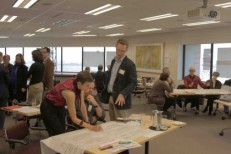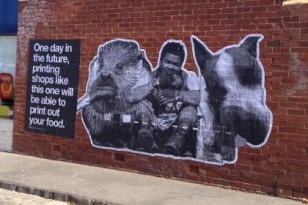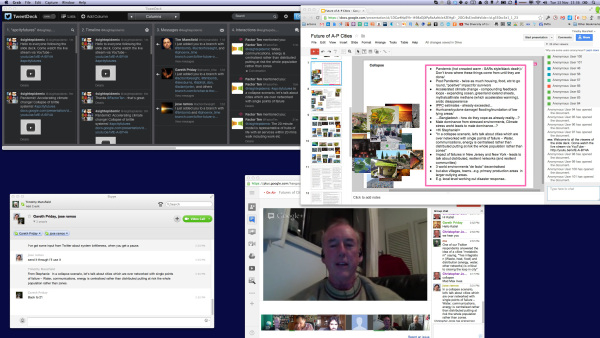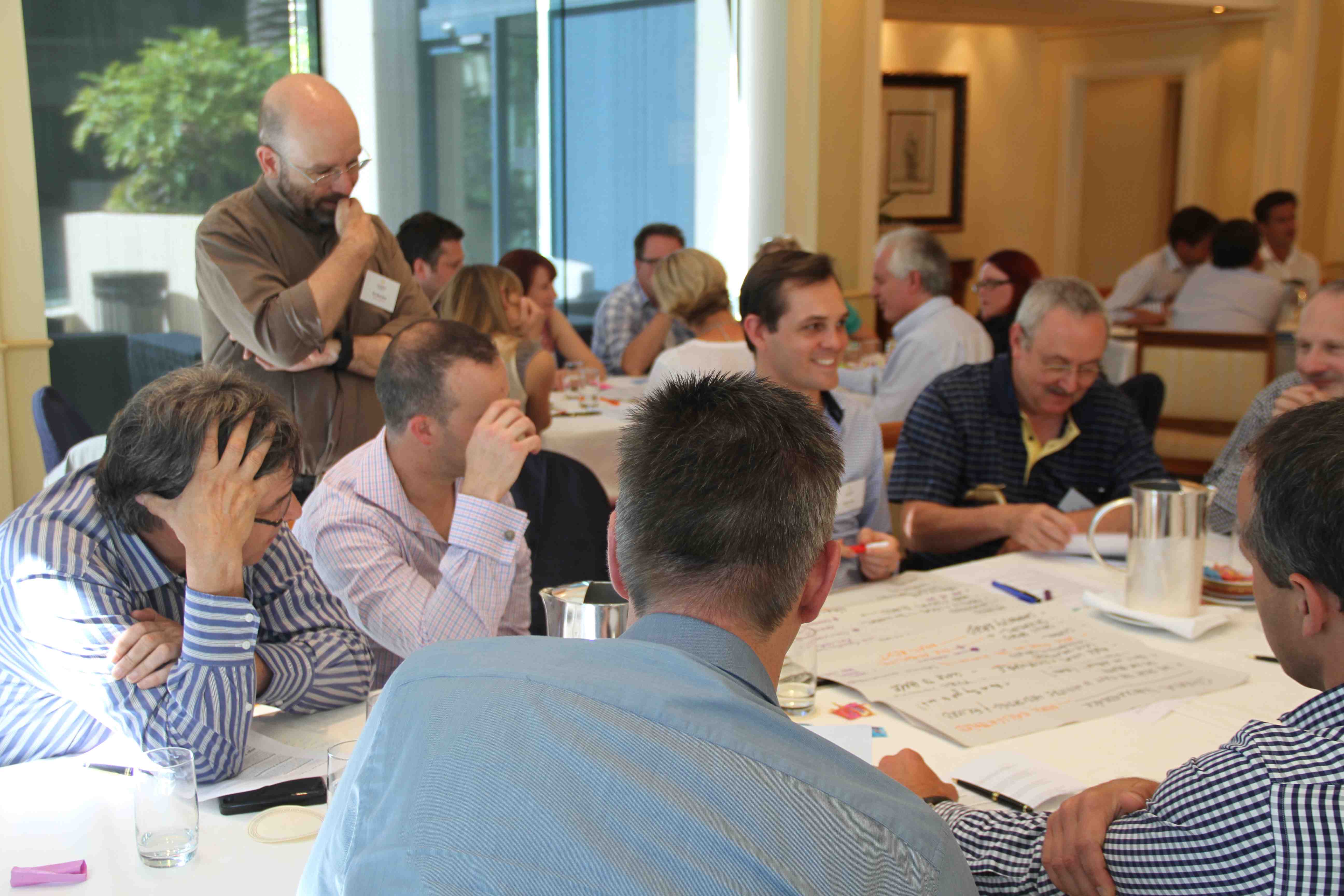Draw upon knowledge ecosystems ….
Futures Prompter
Futures prompter is a simple, low cost social media based engagement process for an organisations wanting to have its staff explore and contribute their ideas about the future of the organisation.
Futures prompter was developed in response to a local council’s desire to involve a broad range of staff in a discussion about which new ideas and technologies to invest in over the next few years. There was a requirement to challenge participants and also leave space for them to contribute their own examples and ideas. Like many organisations councils funds are tight and this had to be a low cost endeavour.
We developed process which can be run on internal social media discussion channels like Yammer. After a brief introduction participants were able to view and comment on different ideas and examples of what the future might hold and how that might be relevant to their organisation. This was presented as a safe space to add ideas and examples. The discussions moved through a sequence of typical future ‘voices’ in organisations (e.g, technological change) so that the was space for different types of views to be heard. At the end of the 3 week discussion participants were invited to rate which were the most important ideas which the council should invest in over the next few years.
It makes sense to use the collective intelligence of your organisation to frame a view of how scarce resources should be spent and to do this you need to engage a large number of people and challenge the dominant in-house thinking. The Futures prompter is a low cost product which can be run in-house by your team to do just that.
If you want to make sure that you’re covering your blind spots before making investment decisions, use futures prompter to engage your most precious resource; your staff, contact us at Action Foresight.
GLAM Innovation Study
CSIRO’s Australian Centre for Broadband Innovation commissioned a study of next steps for digital innovation among Galleries, Libraries, Archives and Museums – the so-called GLAM Sector – in Australia. Action Foresight collaborated with Chris Winter and a team from Smart Services CRC and CSIRO to carry out the study using a foresight-driven approach.
The study used a two-day futures workshop to create a visionary space for the next 10 years in the sector. The attendees worked collaboratively on a set of four key initiatives for the whole sector.
Due to time constraints the workshop was attended by mostly Sydney-based representatives of the sector, so we wanted to ensure that the ideas created by the attendees formed a sound, but forward-thinking agenda for the whole sector nationally. To achieve this, we held over thirty interviews in-person and online with heads and digital leaders in the sector nationally and overseas. The feedback in these interviews ratified and developed the proposals from the workshop.
Issues raised by the study included new ways to access and interact with collections and information, changes to public use of cultural collections and new service and business models to fund and promote activities. While the individual institutions and parts of the sector naturally had their own concerns, it was interesting to discover how similar many of them were.
The final report was released by CSIRO in August 2014 and been distributed to every GLAM institution at the state and federal level and all relevant ministers.
References:
The Open Futures Library – openfutures.net
We would like to introduce the Open Futures Library, a free, publicly-contributed, indexed, searchable collection of future scenarios and other depictions of the future, which we hope will be a component of a larger global foresight commons. Every year Futurists create hundreds of scenarios; designers, scientists, artists, filmmakers and others also create many depictions of alternative futures. These typically appear on websites, some of which have a flurry of activity associated with them and then disappear from public view – and a great resource is subsequently wasted.
In our work with the Smart Service CRC in Australia we became interested in the potential to use existing scenarios as an affordable and easy way of prompting discussions about the future – discussions which supported other methods we used. We felt that there was great potential to explore new methods for small organizations, which normally don’t have the resources for larger scale futures projects. Exploring this idea with other Futurists, we found that many already maintained a set of interesting scenarios. We also found that larger organizations (for example the Australian Tax Office) maintain a database of scenarios. For people who are not regularly scanning for scenarios, finding them can be difficult and time consuming, especially if you have several topic areas to investigate. With the popularity and frequency of scenario use increasing, we felt there was an emerging need for a repository where people can store and explore these depictions of alternate futures.
The Open Futures Library is our answer to this problem. Our goal with the Open Futures Library is to provide a repository which indexes each depiction of the future by the kinds of criteria that matters to users and which makes it reusable. This will make searching for collections of scenarios easier and provide a place to comment on the use and quality of the scenarios. As with the laws of physics, Space and Time are critical variables in the construction and use of scenarios. The current build of Open Futures Library allows users to search and input scenarios by geography (e.g. China) and future-time scale (e.g. 2030). But we hope this is only a starting point.
We believe that that there will be many opportunities to develop the library, for example, being able to work with sets of scenarios in a project format that employs new methods in comparative analysis and synthesis, which may also bring new insight to our current field related practices. While we built it, it is a creative commons resources and belongs to you and the world. We invite you to join the Open Futures Library, give us your thoughts, feedback and shape the next stage of this project. We would like to thank the Futurists and organizations that helped shape and contribute data to this project. The Open Futures Library was developed and supported by the Smart Services CRC, Australia. Thanks also goes to Noah Raford and the Australian Tax Office for providing database content.
Thanks
Gareth Priday, Tim Mansfield, Jose Ramos
This article was originally published in in the April 2014 issue of Compass of the Association of Professional Futurists
Visit the Open Futures Library at http://openfutures.net/
Financial Resilience Living Lab
Action Foresight was thrilled to be asked to manage the Financial Resilience Living Lab pilot for the Financial Resilience CRC bid earlier this year. Living Labs are ‘public-private-people-partnerships’; simply they are places where researchers, business, government, other organisations and people come together research a particular topic. They emphasise co-creation, innovation and sustainability. Living Labs treat the ‘end-user’, you and me, as knowledgeable participants in the whole process contributing to the design, evaluation, topics of study and opportunity rather than being ‘objects of study.’ More generally this is framed as a ‘demand side’ economic innovation policy particularly directed at service creation and directed a an economic view based on the service dominant logic economic theories of Steve Vargo and Robert Lusch.
The Living Lab pilot was a collaboration between Action Foresight, RMIT, Swinburne University, GSM, Smart Services CRC and the tlab participants in Dandenong. Unfortunately the government withdrew support for all CRC’s in this round, but the pilot showed the use of the Living Lab model for this kind of topic.
Our role was to make sure that the co-creation with the participants was central throughout the design of the program – to demonstrate that we could achieve the level of co-creation that could have lead to membership of the European Network of Living Labs the following year. Fortunately our university collaborators were of a similar mindset. The program as based on the best practice tool kit from Enoll. With our collaborators we developed a program that ran through the three key stages of the key iteration of a Living Lab project cycle, understanding the opportunities, designing solutions and evaluating them. The topic theme was based on insurance for people on low incomes. We deliberately looked for non-financial as well as financial solutions. A typical scenario might be that we someone who is working on a casual basis their car breaks down and they can’t afford to get it fixed straight away as a result they can’t get to work for a few days and they lose their job. A small event triggering a much larger loss of income as well as the expense. Here the need is to be able to get to work not just have an insurance policy that protects the car. There may be solutions more akin to Uber than insurance policies.
The Action Foresight team have Living Lab expertise as well as expertise in related fields and techniques that are used in Living labs, such as action research, user centred design and of course futures. Action Foresight can help you design, set-up and run your Living Lab or your Living Lab project. Action Foresight and SustainSA are currently working together with other collaborators to develop the Australian Network of Living Labs with the aim of promoting the development of Living Labs in Australia.
Creating the Age Friendly City: An Initial Evaluation
This research report was commissioned by City of Port Phillip (CoPP) and delivered by Action Foresight with the aim of improving the lives of older residents, both now and in the future. The major objective of this initiative was to provide a broad assessment of municipal strengths, weaknesses and gaps for the City of Port Phillip (CoPP) in relation to the World Health Organisation’s Global Age-friendly Cities: A Guide and the Community Liveability Guide2 developed by Professor Laurie Buys and her team at the Queensland University of Technology (QUT).
The research team drew from workshops, focus groups and interviews, augmented by online surveys administered by the CoPP. An environmental scan of related issues was conducted to provide an outside view and support future policy development within the CoPP.
The project was carried out by DeChantal Hillis, Dr. David Wright, Dr. Laurie Buys and Dr. José Ramos.
Open Futures Library
Every year there are hundreds of quality scenarios developed by futurists in conjunction with industry leaders and universities. To this we can add the many images, videos and short stories that are little ‘snippets’ of alternative futures that people generate each year. These are great resources to start some conversations about what the future might hold, but until recently there was no single place to look for these.
Action Foresight with the support of the Smart Service CRC changed this by developing the Open Futures Library. The Open Futures Library contains hundred of links quality scenarios and other depictions of the future. The library support search by subject, tags, time frame, topics and many other features. It’s free to join and you can add images as well as add comments to existing ones.
This provides you with a free entry point to have a look at some futures work and to be able to use it in your strategy, innovations and organisation design process. The video snippets can act as great conversation starters and the larger documents come with the authority of leading experts in the topic field, great for overcoming the “I don’t believe that” conversation shut down. The larger documents also provide the backing references and materials making them a great place to start your research and update.
Tips and traps for using material from the Futures Library;
- Look for a mix of topic specific and general country, regional or world overviews
- Look at all the scenarios in the set, not just the one that might back your business case
- There are often great summaries which can be used as introductions
- Look for at least one with quality experts to back the conversation
- Use the references to start your own research
- Wind tunnel test you business idea, design or innovation in each scenario in the set.
The Foresight Epidemic
The ‘foresight epidemic’ was a project done as part of research with the Smart Services CRC, to investigate the extent to which contemporary social media can be harnesses as platforms for developing public foresight.
We used a variety of futures studies methods to explore topics chosen by interest from the public. Topics included:
· The futures of citizen insurgencies
· The futures of work
· The futures of childhood education
· The future of cities in the Asia Pacific
With each topic we employed a new futures method that we twined with a new social media strategy. We followed an action research strategy of 1) designing a new foresight approach, 2) running it as an experiment in engagement, 3) evaluating how it went. We also employed triple loop learning theory to test our team assumptions with regard to the ‘why’ of the activity (purpose), the strategies we considered best and the tactical and operational dimensions of what we were doing.
Critical insights from the action learning experiment included:
· The power of images in facilitating people’s engagement and ability to mash-up scenarios
· The importance of distributed and embodied ‘co-presence’ – even while not physically present, sensory engagement is still fundamental
· The potential for twining physical and virtual interactions is real but requires design and intelligent implementation
· Smaller groups engaging in coherent and high quality conversations about the future is preferable to large scale groups with less coherence – there is a trade off with the scale and network capacity of social media.
Bendigo a Thinking Community
In 2012 we put forward a proposal to run an intensive and large scale foresight capacity development process for the citizens of Bendigo in Victoria, Australia. The objective of Bendigo-A Thinking Community was to encourage and engage with the community to think deeply and strategically about expectations and aspirations to develop a more prosperous, liveable and sustainable society.
A rural city two hours (by train) North-West of Melbourne, Bendigo is facing a number of long term challenges and changes. The current population of approximately 100,000 is set to increase dramatically over the coming decades. Demographic shifts and new migrant populations are changing the cultural landscape. The impact of climate change, already felt in the region, remains an ever present and uncertain factor. The industrial and economic base of the city is also in transition.
We were engaged to run a nine month foresight program for 50 participants, the goal of which was
to inspire [the] city to become renowned as a thinking city. A city, that can think creatively for the long-term. A city, that attracts and inspires the most creative people. A city that thinks beyond the next political poll, TV series or annual report. We already have wonderful thinkers in Bendigo. But do we have the skill set as a City to think long term? Can we inspire our community to be actively engaged thinkers?
In 2013 we designed and over nine months ran a program that involved four full day live large group workshops and six online webinars. The content of the workshop include:
· Using the Futures Action Model as a framework to facilitate foresight informed social innovation
· Setting up and facilitating a social media platform for a shared Horizon Scanning process
· Group / team based exploration of a variety of foresight themes and innovation topics, many which led to social interventions and innovations
· Use of the Three Horizons framework of change to help groups conceptualize change strategies
· Use of a narrative foresight approach, including the use of Causal Layered Analysis, to create a new story / narrative for the development of the region.
· Production of a story artifact.
NORA Leader’s Summit
The National Online Retailers Association (NORA) is the peak body for online retailers in Australia. Bringing its members together for its inaugural conference in 2013, NORA wanted to provide and space to collaborate, network and articulate the needs of its members. Over the day and half event the attendees were able to share their thoughts about the future and explore these through six archetypal futures. In an industry driven by hourly results, thinking about the future can be difficult but our program was designed to provide both stimulation and a sense of safety. Over the course of the event the attendees – many of whom had never met – were able to created connections and articulate a desired future for their industry.











